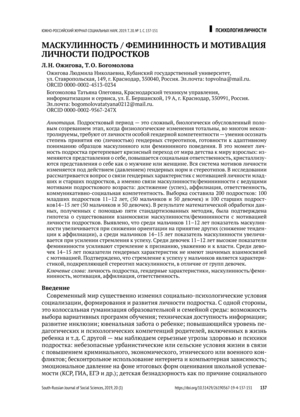Аннотация
Подростковый период — это сложный, биологически обусловленный половым созреванием этап, когда физиологические изменения тотальны, во многом неконтролируемы, требуют от личности особой гендерной компетентности — умения осознать степень принятия ею (личностью) гендерных стереотипов, готовности к адаптивному пониманию образцов маскулинного или фемининного поведения. В это момент личность подростка претерпевает кризисный переход от мира детства к миру взрослых: изменяются представления о себе, повышается социальная ответственность, кристаллизуются представления о себе как о мужчине или женщине. Вся система мотивов личности изменяется под действием (давлением) гендерных норм и стереотипов. В исследовании рассматривается вопрос о связи гендерных характеристик с мотивацией личности младших и старших подростков, а именно связи маскулинности/фемининности с ведущими мотивами подросткового возраста: достижение (успех), аффилиация, ответственность, коммуникативно-социальная компетентность. Выборка составила 200 подростков: 100 младших подростков 11–12 лет, (50 мальчиков и 50 девочек) и 100 старших подростков 14–15 лет (50 мальчиков и 50 девочек). В результате математической обработки данных, полученных с помощью пяти стандартизованных методик, была подтверждена гипотеза о существовании взаимосвязи маскулинности/фемининности с мотивацией личности подростков. Выявлено, что среди мальчиков 11–12 лет показатель маскулинности увеличивается при снижении ориентации на принятие других (снижение тенденции к аффилиации), а среди мальчиков 14–15 лет показатель маскулинности увеличивается при усилении стремления к успеху. Среди девочек 11–12 лет высокие показатели фемининности усиливают стремление к признанию, уважению и к власти. Среди девочек 14–15 лет показатели гендерных характеристик не имеют значимых взаимосвязей с мотивацией. Подтверждено, что стремление к успеху у мальчиков является характеристикой, подкрепляющей стереотип маскулинности, в отличие от групп девочек.
Ключевые слова
Библиографические ссылки
Bobkova, T. S. (2014). Kharakteristika sostavliaiushchikh polovoi identifikatsii podrostkov v raznykh sotsial’no-pedagogicheskikh situatsiiakh razvitiia [Constituents of the Teens’ Gender Identification in Various Situations of Educational Progress, and Their Characteristics]. Sibirskii pedagogicheskii zhurnal [Siberian Pedagogical Journal], 4, 185-190.
Connell R. (1987). Gender and Power: Society, the Person and Sexual Politics. Cambridge: Polity Press.
Daniels, E., Zurbriggen, E. (2016). The Price of Sexy: Viewers’ Perceptions of a Sexualized Versus Nonsexualized Facebook Profile Photograph. Psychology of PopularMedia Culture, 5 (1), 2–14.
Fel’dshtein, D. I. (1972). Trudnyi podrostok:nekotorye psikhologicheskie voprosy formirovaniia lichnosti detei podrostkovogo vozrasta [A problem Teenager: Some Psychological Questions of the Formation of Teenager Personality]. Dushanbe: Irfon.
Glushko, I. V. (2014). Sotsial’noe doverie v kontekste mezhlichnostnykh otnoshenii [Social Trust in the Context of Interpersonal Environment]. Istoricheskaia i sotsial’no-obrazovatel’naia mysl’ [Social Trust Within the Frame of Interpersonal Relations], 2 (24), 213-216.
Khekkhauzen, Kh. (2003). Motivatsiia i deiatel’nost’ [Motivation and activity]. Moskva: Smysl.
Kulagina, I. Iu. (1999). Vozrastnaia psikhologiia: razvitie rebenka ot rozhdeniiado 17 let [Developmental Psychology: a Child’s Development Since Birth to 17 Years of Age]. Moskva.
Marchenko, O. Iu. (2014). Osobennosti gendernoi identichnosti u shkol’nikov raznogo vozrasta [The Specifics of Gender Identification in Schoolchildren of Different Age Groups]. Pedagogika, psihologiya i mediko-biologicheskie problemy fizicheskogo vospitaniya i sporta [Pedagogics, Psychology, Medical-Biological Problems of Physical Training and Sports], 1, 37-41.
Norkulova, N. T. (2014). Motiv affiliatsii kak osnovnoi faktor formirovaniia splochennosti molodezhnykh grupp [Motive of Affiliation as the Main Factor of Unity in Youth Groups]. Problemy sovremennogo obrazovaniia [Problems of Modern Education], 5, 116-127.
Obozov, N. N. (1990). Psikhologiia mezhlichnostnykh otnoshenii [The Psychology of Interpersonal Relations]. Kiev.
Ozhigova, L. N. (2006). Psikhologiia gendernoi identichnosti lichnosti [The Psychology of a Personality’s Gender Identity]. Krasnodar.
Petroniuk, I. S. (2015). Vliianie sotsial’no-psikhologicheskoi adaptatsii podrostkov na stanovlenie ikh sistemy tsennostei [The Influence of the Teens’ Social and Pedagogical Adaptation Upon the Formation of Their Value System]. Izvestiya Sankt-Peterburgskogo gosudarstvennogo agrarnogo universiteta [Izvestiya Saint-Petersburg State Agrarian University], 105-108.
Polianskii, A. I., Sukhareva, E. A. (2017) Vzaimosviaz’ pokazatelia “sootvetstvie gendernomu stereotipu’ s lichnostnoi trevozhnost’iu i samootsenkoi [Relationship of the Indicator “Accordance with the Gender Stereotype” to Personal Anxiety and Self-Esteem]. Nauchnye trudy Moskovskogo gumanitarnogo universiteta [Scholarly Works of Moscow University for the Humanities], 3, 68-74.
Prosvirina, N. N. (2015). Formirovanie tsennostnykh orientatsii kak uslovie psikhologicheskoi bezopasnosti podrostka [The Formation of Values as a Condition of Psychological Security Teenager]. Kontsept [Concept], 1, 24-29.
Rodshtein, M. N. (2017). Konflikt ideal’nykh gendernykh ia-obrazov i real’nykh ia-predstavlenii uchashchikhsia podrostkovogo vozrasta [Conflict of Teenagers’ Ideal Gender-Based I-Concepts and Real I-Images]. Povolzhskii pedagogicheskii vestnik [Pedagogical Gerald of Volga Region], 3 (16), 72–79.
Shaboltas, A. V. (1995). Metodika diagnostiki motivov zaniatiia sportom v iunosheskom vozraste [Methods of Diagnosing Teenagers’ Motivation for Sports Activities]. Vestnik SPbGU [Vestnik of Saint Petersburg University], 3. 129–132.
Urusova, L. Kh. (2014). Etnopedagogika: gendernye standarty maskulinnosti [Ethnopedagogics: Gender Standards of Masculinity]. Vestnik Kemerovskogo gosudarstvennogo universiteta [Bulletin of Kemerovo State University], 41 (60), 96-98.
Urusova, L. Kh. (2015). Vospitanie svobodnoi lichnosti: differentsirovannyi podkhod [Educating a Free Personality: a Differentiated Approach]. Vestnik Kemerovskogogosudarstvennogo universiteta [Bulletin of Kemerovo State University], 1-2 (61), 128-130
Urusova, L. Kh. (2016). Kognitivnaia teoriia moral’nogo razvitiia Kolberga kak uslovie uspeshnoi sotsializatsii sovremennoi lichnosti [Colberg’s Cognitive Theory of Moral Development as a Condition of the Successful Socialization of a Modern Personality]. Vestnik Vostochno-Sibirskogo gosudarstvennogo universiteta tekhnologii i upravleniia [Economics Bulletin of Eastern-Siberian State University of Technologies and Management], 4 (61), 167–171.


